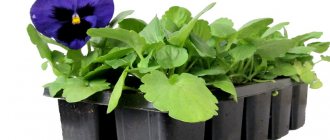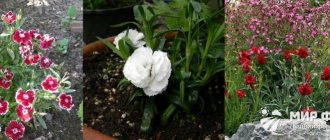Viola, Wittrock violet or Pansy have been popular among gardeners for many years. Our grandmothers planted them in their gardens and summer cottages. And this is not surprising, because the bright colors of flowers can decorate any flower bed. Viola is grown as a biennial plant, which can be planted in the spring as seedlings or directly in open ground, or can be sown in the garden at the end of summer. You can learn about the timing and rules for planting and caring for pansies in our article. If the question is relevant to you - how and when to plant lobelia and petunia, follow the highlighted links.
When to plant viola seedlings in 2022?
Pansy seeds should be sown for seedlings in late February or early March .
In 2022, according to the Lunar calendar, the following days are considered favorable for this: February 3, 4, 12, 13, 14. Less favorable, but suitable for flowers, sowing dates: February 17, 18, 21 to 26, 2022. It is not recommended to sow and plant on February 1, 2, 16 and 16 and 28. If the viola was not planted at the end of February, sowing can be done in March 2022: 3, 11, 12, 13, 16, 17 or from 21 to 26. Viola planted in February - March will bloom in the summer of the same year, and the next year it will begin to bloom in early spring.
A little late, but you can still sow pansy seedlings on April 8, 9, 13, 14, 2022. In the southern regions, crops are sown immediately in open ground in April. Less favorable dates: from April 17 to 22, 26 and 27.
Only in August will flowers appear on the viola if you sow the seeds immediately in open ground in May or June . Flowering will be late, and the fallen snow will cover the pansies along with the flowers. When the snow melts in the spring, you can see viola flowers.
In May, the following days are considered favorable for planting flowers: 5, 6, 7, 10, 11, 12, 14, 15 or 23, 24, 27, 28, 29. In June, seeds can be planted on 1, 2, 3, 6, 7 , 8, 11, 12, 30th. You can plant pansies directly in open ground in August or September, then the Wittrock violet can bloom the following year in the spring. In August, favorable days for sowing are 1, 4, 5, 6, 7, 8, 9, 10, 28, 29, in September 2022: 1, 2, 3, 4, 5, 6, 9, 28, 29, 30 However, the seedling method is more reliable than the non-seedling method, so many gardeners sow pansy seeds in February or March.
Collecting pansy seeds
Seeds for sowing should be collected at the end of summer. When the bolls ripen after the faded flowers and turn upward, it’s time to collect the seeds.
The boxes are cut off and small seeds are shaken out onto a sheet of paper. The planting material is dried at room temperature and then placed in paper bags for storage in the refrigerator.
If the seed pods are not removed, the viola will reproduce by self-sowing, and then spontaneous shoots can be seen in late autumn or early spring. If you thin out the seedlings, you can grow violas in the same place without wasting time collecting seeds and sowing.
Growing viola from seeds step by step with photos
Sowing viola for seedlings
At the end of February or beginning of March, when there are favorable days according to the lunar calendar, pansy seeds are sown for seedlings. You can choose any containers for this, and soil for viola can be bought at a specialized store. The best soil for violets. But if you are used to preparing the substrate yourself, then mix the following ingredients:
- sand – 1;
- humus – part 2;
- peat – part 2;
- garden soil - 2 parts.
You will be interested to know: Feeding petunia for growth and abundant flowering: when and how to feed petunia with folk remedies and fertilizers
Before planting, it is recommended to soak viola seeds in a solution of Zircon or Epin and leave for a day.
Seedling containers should be filled with a moist substrate, in which grooves no more than 0.5 cm deep are made. The distance between them should be about one centimeter. Seeds are placed in the grooves at a distance of 1-2 cm and sprinkled with soil sifted through a sieve.
The crops are sprayed from above with warm water from a spray bottle and covered with glass or cling film. The resulting greenhouse is placed in a warm place with an air temperature within +20...+25 degrees. You can place containers under the battery, since the crops do not need lighting before germination.
To prevent the soil from becoming moldy, the cover from the containers should be removed for a few minutes every day and at the same time checked the degree of soil moisture. If it starts to dry out, you need to spray it with water from a spray bottle.
Caring for viola seedlings
After about 7-10 days, shoots will appear, and the seedling containers will need to be placed in a well-lit place with bright, diffused light. Tender plants should not be exposed to direct sunlight. To prevent the seedlings from stretching, they are placed in a cool room with an air temperature of about +10 degrees. To do this, you can place the seedlings on a glassed-in loggia.
If it is not possible to provide the plants with cool conditions, you can place the viola on the windowsill. There is no need to remove the cover immediately. First, seedlings should be accustomed to the open air of a room. This should be done gradually, ventilating the seedlings every day for an increasingly longer period of time.
Watering and fertilizing seedlings
Young seedlings that have not yet become strong need moisture, so it is necessary to ensure that the soil in the containers does not dry out.
When the top layer of soil begins to dry out, it should be moistened. Violas love moisture, but at the same time they cannot tolerate stagnation of water in the soil, which causes them to rot. In order for the seedlings to grow strong and not stretch out, it is recommended to feed them twice a month with mineral fertilizers for seedlings or for violets.
Picking and pinching
Grown seedlings with one or two true leaves are transplanted into separate pots or into wider and deeper containers with a distance of at least 5-7 cm from each other.
If the seedlings have stretched out, then when planting the bushes should be buried down to the cotyledon leaves. As a result of such planting, additional roots are formed on the buried stem, due to which the bushes will develop better.
Transplantation of pansies is tolerated well, so there is no need to be afraid to pick them. Even a flowering viola will quickly acclimatize after transplantation and begin to grow further.
For better tillering, it is recommended to pinch the Wittrock violet as soon as 2-3 true leaves appear on it.
Useful video
We recommend watching a short video about planting viola seedlings:
Viola is an extraordinary flower. His tenderness and radiance of love amazes. The plant will be a cute decoration for your garden, terrace or yard. You can grow it from seeds using the seedling method yourself, and the number of seeds in one package of seeds is enough for an average lush flowerbed.
Found any inaccuracies or false information? Do you have any suggestions to improve the article?
Would you like to suggest photos for publication?
Please help us make the site better! Leave a message and your contacts in the comments - we will definitely contact you!
Viola: planting and care in the garden and on the balcony
When warm weather sets in and the temperature remains above zero even at night, garden pansy seedlings can be planted in open ground or in flowerpots on the balcony.
Therefore, planting dates depend on the climate in the region. For the viola, a sunny area is selected, on which there will be shade in the afternoon. Holes for planting are dug at a distance of 10-15 centimeters from each other. The soil removed from the hole is mixed with crushed charcoal and humus (1: 0.2: 0.2). The bottom of the hole is covered with a small layer of nutritious soil, on which the plant removed along with the lump of earth is placed. The roots of the bush are sprinkled with a nutrient mixture and watered well.
You will be interested to know: How to fertilize peonies in August: options for fertilizing after flowering
When growing violas on the balcony, they are planted in boxes or flowerpots with the same distance of 10-15 cm. Containers for growing pansies are filled with soil for violets or a mixture, the recipe for which is given above. You can plant pansies in boxes, flowerpots and flowerpots immediately when picking them, and when it gets warmer outside, they can be taken out to the open balcony. During the first days, the plants should be kept in the fresh air for several hours, gradually increasing the time spent on the balcony. When warm weather sets in, containers with viola, which may already be blooming, are placed on the balcony without fear, because the plants have already hardened.
Features of caring for viola include:
- Regular watering. The soil under pansies should always be moist and loose. Therefore, after watering, the soil around the bushes is loosened every week. If the summer is hot and without rain, then the plantings should be watered daily. Pansies growing in boxes and flowerpots are watered in the morning and evening.
- Every month, plants should be fed with superphosphate or ammonium nitrate, using 25 grams of fertilizer per square meter. For plants growing on balconies or verandas in containers, fertilizers for violets or ordinary complex mineral fertilizers are suitable.
- Withered flowers should be picked off immediately so that the viola blooms abundantly. Otherwise, all the plant’s energy will be spent on producing seeds and not on forming buds.
As you can see, caring for pansies is quite simple and will not cause much difficulty even for those who have decided to take up gardening for the first time.
Sowing viola in open ground
In order not to bother with growing seedlings, pansies can be sown in the spring or at the end of summer directly into the flowerbed. To do this, dig up the bed and make grooves 0.3-0.6 mm deep in it. The distance between the grooves and the seeds should be 10-15 cm. Since not all seeds can sprout, they can be sown more crowded. If all the planting material has sprouted, weaker seedlings can be removed or the bushes can be planted more freely.
Crops should be well watered and can be covered with polyethylene. The seedlings are watered regularly and fed every month. When 2-3 true leaves appear on them, pinch out the bushes.
Violas planted in late May or early June will bloom in August.
Preparation of planting material
Before sowing seeds, it is necessary to carry out preparatory work. To begin with, the planting material needs to be soaked in warm water. Then it should be treated with growth stimulants.
Such drugs as Epin and Zircon have proven themselves well. Such procedures will increase the resistance of seedlings to adverse weather conditions.
Viola flower - types and varieties
Viola Wittrock
The most common type of viola, which has a second name, is pansy. In culture, Wittrock violet is grown as a biennial plant. It has many varieties that differ in shape, color and size of flowers. The color of the buds can be one-color, two-color or spotted.
Popular varieties of single-color Wittrock violas:
- Wittrock's red violet - a plant up to 20 cm high blooms with red flowers with a dark eye. The buds reach 7 cm in diameter.
- Rua de Negri - the variety is distinguished by bluish leaves, up to 23 cm high and flowering from early spring until frost. Up to 15 buds with double black petals and a bright yellow eye can bloom simultaneously on one bush.
- Blue Boy is a large-flowered plant, the diameter of the flowers is about 6 cm. A bush with bluish leaves reaches a height of 20 cm. Up to 20 flowers with corrugated lilac-blue petals can bloom on it at once. There are lilac strokes at the base of the petals.
- Viola white - the variety is distinguished by long peduncles on which fragrant white flowers with a yellow or green tint bloom. The bush is about 20 cm high and wide and can grow up to 25 cm.
You will be interested to know: Nemesia: varieties with photos, growing from seeds, when and how to plant seedlings step by step
Bicolor varieties:
- Saint Knud is a compact plant up to 20 cm high, blooms profusely and is covered with green leaves. The buds have two types of petal colors: the bright orange lower ones have a red base, and the upper ones have an orange-yellow tint.
- Lord Beaconsfield - the variety is distinguished by flowers with a diameter of 5.5 cm, bluish leaves and a height of up to 25 cm. Up to 30 buds can bloom on the plant at the same time, the lower petals are purple with lilac edges, and the upper ones are white and blue. The upper petals seem to have ink strokes on them.
- Jupiter - a small bush up to 16 cm high blooms with white-violet flowers, the lower petals of which have a dark purple hue and a velvety structure.
Spotted violas:
- Cassis is a profusely flowering hybrid variety with buds with purple petals, the edges of which are white.
- Tiger Eyes is a hybrid with small flowers up to 3 cm in diameter. Brown streaks are scattered on their yellow petals.
- Shalom Purim is a large-flowered plant with ruffled petals. The variety is sold as a mixture of seeds from which violas of various colors grow.
Plant information
Plants of the violet family thrive in temperate latitudes. Their habitat is foothills. Pansies grow and adapt well at home. There are about seven hundred species of plants. They differ in color, size, flowering period and adaptability to climatic conditions.
Most often, the inflorescences come in three colors, but there are also solid ones. The plant is a biennial. To see pansies in all their glory in the first year, you need to start seedlings in winter. The variety of shades is demonstrated by photos of flowers.
Beautiful and unpretentious pansies, the cultivation of which is now on a commercial basis, were known 2 thousand years ago. Flowers were used to weave wreaths, arches, and decorate holidays and celebrations.
The lifespan of a viola varies from one year to several years. It has a straight shoot and a fibrous root. Depending on the variety, the leaves have the shape of a basal rosette or are distributed along the stem. The flowers are very picturesque: monochromatic, two or three colors. They can be wavy or terry. Some varieties produce flowers up to 7 centimeters in diameter.











